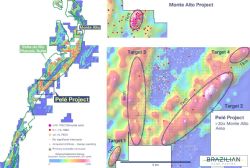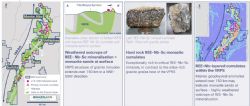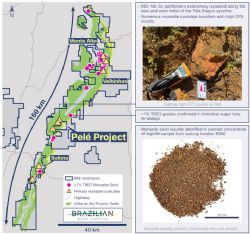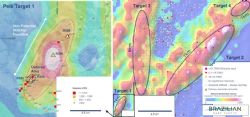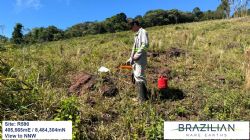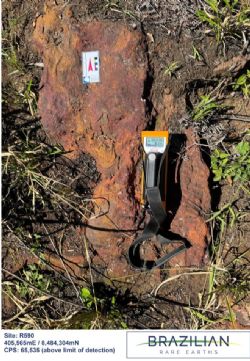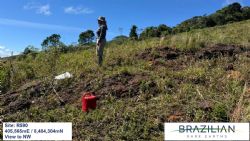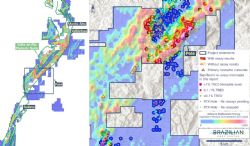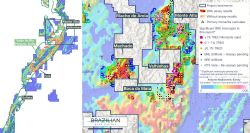BRE Announces New Rare Earth Discovery - the Pele Project
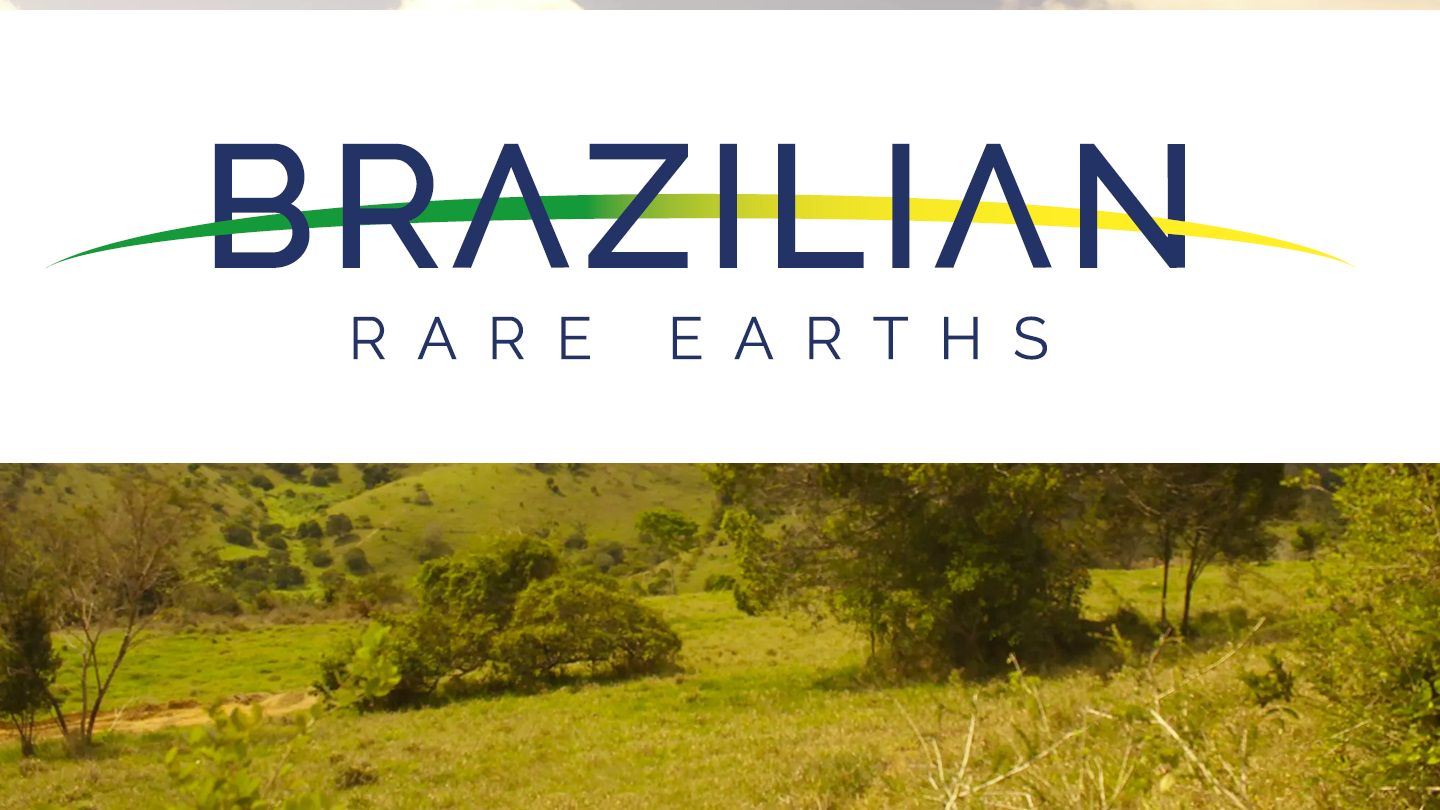
BRE Announces New Rare Earth Discovery - the Pele Project
Sydney, Mar 25, 2024 AEST (ABN Newswire) - Brazilian Rare Earths Limited ( ASX:BRE) is pleased to report the first batch of re-assay results from the Rio Tinto exploration dataset and the receipt of new assays from BRE drilling across the Rocha da Rocha Rare Earth Province in Bahia, Brazil.
ASX:BRE) is pleased to report the first batch of re-assay results from the Rio Tinto exploration dataset and the receipt of new assays from BRE drilling across the Rocha da Rocha Rare Earth Province in Bahia, Brazil.
- Discovery of a new district-scale rare earth exploration project, named the 'Pele Project', located circa 60km southwest of Monte Alto
- The Pele Project is highly prospective for ultra-high grade REE-Nb-Sc mineralisation with a district-scale exploration target area that is +30 times larger than Monte Alto
- Pele discovered using the exploration pathfinders that successfully delineated the world-class ultra-high grade Monte Alto Project, including intense geophysical anomalies, confirmed hard rock REE outcrops and high-grade monazite sands at surface
- Initial ground reconnaissance at Pele Target 1 has discovered the largest continuous hard rock monazite outcrop found since exploration commenced at the province, and it currently extends over a strike of ~30m (open) within a larger 1km NNE potential outcrop trendline
- This large-scale monazite outcrop recorded gamma readings comparable to the ultra-high grade REENb-Sc mineralisation at Monte Alto, which returned exceptional grades of up to 5.9% (59,100ppm) NdPr, 3,229ppm DyTb , 1.5% niobium and 352ppm scandium
- High-grade monazite sand intercepts of up to 11.5% TREO from the first batch of re-assays from Rio Tinto drill holes across the Pele exploration target, with assays pending for 220 high-priority drill holes (2,700m) that cover Pele's intense geophysical anomalies
- Comprehensive gamma line surveys will be expedited over the highly prospective 15km exploration corridors on Pele Targets 1-4 in preparation for a maiden diamond drilling program
A new rare earth discovery, the Pele Project, has been made ~60km southwest of Monte Alto. This greenfield discovery is highly prospective for ultra-high grade REE-Nb-Sc mineralisation, with multiple exploration pathfinders indicating the scale of a world-class rare earth mineralised system.
Pele contains the most extensive area of intense geophysical anomalies within BRE's province-scale ~4,000km2 landholdings. Pele Target 1 is distinguished by the largest continuous hard rock monazite cumulate outcrop discovered since exploration commenced at the province, and it currently extends over a strike of ~30m (open) within a larger 1km NNE potential hard rock outcrop trendline.
The latest assay results from the wider regional exploration program and the initial results from the Rio Tinto re-assay program confirm the exceptional potential for new rare earth discoveries across BRE's landholdings.
These exploration landholdings were strategically acquired to secure control of the Volta do Rio Plutonic Suite mineralised trendline that stretches over 160km down the spine of the Rocha da Rocha Rare Earth Province (Figure 2*).
The Volta do Rio Plutonic Suite (VRPS) is hosted within the Archean age Jequie Complex and forms the prime exploration target zone for ultra-high grade REE-Nb-Sc mineralisation. The VRPS is distinguished by a bimodal formation of granitoids and REE-Nb-Sc rich leucogranites. The high-grade REE-Nb-Sc leucogranites are layered within the province scale VRPS from the separation progression of the parent magma.
Brazilian Rare Earths' CEO and MD, Bernardo da Veiga, commented:
"Less than two years after the discovery of the Monte Alto project we are pleased to announce our fourth greenfield rare earth project at this world-class rare earth province.
The Pele Project is district-scale rare earth project with an exploration target area that is over 30 times larger than the Monte Alto Project. The scale of the exploration opportunity is exceptional and the recent discovery of a massive monazite mineralised outcrop at Pele Target 1 indicates the potential for a major rare earth endowment.
With the proven Monte Alto exploration pathfinders already at hand at Pele, and the extensive assay results from the Rio Tinto dataset now imminent, we now intend to accelerate plans for a maiden diamond drilling program at Pele."
Monte Alto Project - Successful Exploration Pathfinders
The discovery of the world-class Monte Alto project was based on three key exploration pathfinders:
- Geophysical anomaly: BRE's proprietary airborne radiometric survey defined an intense geophysical anomaly over Monte Alto
- Monazite sands: Auger drilling at Monte Alto intersected high grade (+1% TREO) monazite sands near surface. These monazite sands represent a highly weathered 'outcrop' of REE-Nb-Sc mineralisation and a significant indicator for potential ultra-high grade REE-Nb-Sc mineralisation at depth
- Hard rock REE-Nb-Sc outcrops: The discovery of REE-Nb-Sc boulders and outcrops supported the exploration model for ultra-high grade REE-Nb-Sc mineralisation at depth
BRE completed a comprehensive gamma line survey at Monte Alto to map a high-grade monazite sand corridor which then underpinned the design of the maiden diamond drilling program. This maiden diamond drilling program successfully discovered ultra-high grade REE-Nb-Sc mineralisation at Monte Alto.
Pele Project Discovery - Confirmed Exploration Pathfinders
The Pele Project has been discovered using the same exploration pathfinders that were successfully proven at the ultra-high grade Monte Alto Project.
- Geophysical anomaly: Airborne radiometric survey data across the Pele Project area defines a cumulative 15km chain of intense geophysical anomalies for targeted exploration
- Monazite sands: The first batch of re-assays from Rio Tinto auger drilling returned high grades of up to 11.5% TREO. As with Monte Alto, the exploration model is that these monazite sands represent highly weathered 'outcrops' of REE-Nb-Sc mineralisation
- Hard rock outcrops: Initial field reconnaissance at Pele discovered extensive monazite cumulate outcrops with comparable gamma readings to the ultra-high grade mineralisation at Monte Alto
Pele Geophysical Anomaly
Analysis of the airborne radiometric data over the Pele Project identified an extensive chain of intense anomalies recurring on the eastern and western limbs of the regional Tres Bracos syncline. These anomalies across Pele Targets 1-4 have a cumulative strike of ~15km and define a highly prospective exploration target area that is over 30 times larger than the Monte Alto project (Figure 4*).
Pele Ground Reconnaissance - Large-scale Monazite Outcrop Discovery
The BRE exploration team recently conducted initial ground reconnaissance exploration over the southern zone of the Pele Project area (Pele Target 1). A gamma spectrometry survey quickly discovered the largest continuous hard rock monazite outcrop found since exploration commenced at the province, which currently extends over a strike of ~30m (open) within a larger 1km NNE potential outcrop trendline (Figure 4 and 5*).
BRE geophysicists used a RS-230 Portable Gamma Spectrometer positioned over the outcrops to measure a Count of gamma particles Per Second (CPS). There is an established strong correlation between high CPS readings and the high grade REE-Nb-Sc mineralisation at the Monte Alto project.
Gamma spectrometry has thus proven to be an effective method to identify primary high-grade REE-Nb-Sc mineralisation throughout the entire province. This ground based geophysical survey method led to the discovery of REE-Nb-Sc mineralisation at the Monte Alto, Velhinhas and Sulista projects.
High CPS values were recorded at multiple outcrops along an extensive 1km trendline at Pele Target 1, located at the south-western extent of the Pele Project exploration area (Figure 4*). Ground based surveys recorded CPS values ranging from 12,000 to the maximum detectible level of 65,500 at sites R589 and R590 (see Figure 6*).
These gamma survey sites define a large-scale monazite cumulate outcrop that currently strikes ~30m and is open (Figure 7*), within a larger 1km NNE potential hard rock outcrop trendline. The recorded CPS values are comparable to those measured for the ultra-high grade REE-Nb-Sc mineralisation at Monte Alto and represent an intensity of ~20 to 50 times the background CPS values for the region.
Rio Tinto Re-Assay Program
The highest priority Rio Tinto auger drill samples that cover the VRPS and key geophysical anomalies have now been dispatched for re-assay. Exploration assay results for over 11,000m of these high-priority drill holes are expected in the coming months.
The first batch of the rare earth re-assays that cover the Pele target confirmed shallow mineralisation with grades of +1% TREO, and monazite sands have been visually confirmed in the drill hole samples. Significant assays from the surface saprolite include:
- 19m at 4.2% TREO from 0.5m, with 20.8% of NdPr and 1.2% of DyTb (AMBX3124)
- 14m at 0.5% TREO from surface, with 19.4% of NdPr and 0.9% of DyTb (AMBX3141)
- Including 3.5m at 10.7% TREO from 3.5m, with 19.2% of NdPr and 0.9% of DyTb, and
- 1m at 10.4% TREO from 13m, with 20.8% of NdPr and 1.1% of DyTb (AMBX3141 - open at depth)
- 2m at 1.1% TREO from 9m, with 19.5% of NdPr and 0.6% of DyTb (AMBX1492)
The first batch of re-assays included results from 152 Rio Tinto drill holes at the Pele target with an average depth of 14m. These holes targeted the upper laterite layer and, as such, the REE enriched saprolite horizons below this depth remain largely untested. The highest-grade rare earth assay value of 0.5m at 11.5% TREO was intersected at the end of hole MBX3141 at 13.5m, with the mineralisation open at depth. BRE will deploy auger and sonic drilling to extend the exploration into the REE enriched saprolite horizons.
As illustrated in Figure 8* below, the Pele exploration target area is extensively covered by shallow Rio Tinto auger drilling and there are 220 pending re-assay results (~2,700m) that are expected to be received in the coming months.
Surface Drilling at Monte Alto and Velhinhas Projects
In addition to the Phase II diamond drilling campaign underway at the Monte Alto project, an auger drilling program has advanced across the project area to extend the monazite sand resource estimate of 25.2 Mt at 1.0% TREO.
Auger drilling across the Monte Alto exploration project area continues to discover shallow high-grade rare earth mineralisation. Significant new rare earth assays include:
- 21.9m at 1.9% TREO from surface, with 13.3% of NdPr and 0.7% of DyTb (STU0957)
- Including 1.9m at 10.4% TREO from 20m, with 14.4% of NdPr and 0.8% of DyTb (STU0957 - open at depth)
- 19m at 4.8% TREO from surface with 14.9% of NdPr and 0.8% of DyTb (STU0969 - open at depth)
- Including 7.5m at 10.5% TREO from 0.5m, with 14.5% of NdPr and 0.8% of DyTb (STU0969)
- 15m at 2.6% TREO from 9m, with 18.1% of NdPr and 0.9% of DyTb (STU0551)
Significant new assays from the shallow auger drilling exploration program at the Velhinhas project include:
- 13.5m at 0.9% TREO from surface, with 17.8% of NdPr and 0.9% of DyTb (STU0596 - open at depth)
- Including 4m at 2.8% TREO from 4m, with 18.0% of NdPr and 0.9% of DyTb (SSU0097)
- 19m at 1.3% TREO from surface, with 17.1% of NdPr and 0.7% of DyTb (STU0867)
- Including 5m at 4.6% TREO from 4m, with 17.3% of NdPr and 0.6% of DyTb (STU0867)
Next Steps
The highest priority Rio Tinto auger drill samples that cover the VRPS and key geophysical anomalies have now been dispatched for re-assay. Exploration assay results for over 11,000m from these high-priority drill holes are expected in the coming months.
At Pele Target 1, detailed ground reconnaissance and gamma line surveys will be expedited over the potential 1km monazite cumulate outcrop trendline. Once the extensive outcrops and surface rock formations are systematically mapped, this highly prospective exploration trendline will be drill ready for step-back holes to explore the full extent of the mineralised system at depth.
Comprehensive gamma line surveys will be conducted over the highly prospective ~15km exploration corridors at Pele Targets 2, 3 and 4 to assist with the design of targeted diamond drilling exploration programs.
The Phase II extension and infill diamond drilling campaign at the Monte Alto project remains on schedule and is expected to be completed by mid-year.
At the Sulista Project, the diamond drillhole to twin the historical high-grade REE-Nb-Sc intercept has been completed and dispatched with the historical core samples for laboratory assays. Mineralized intercepts +1% TREO from within the historical database of ~5,000m of auger drill holes have also been sent for laboratory reassay with results expected early in the second quarter. Ground based reconnaissance and gamma line surveys are now underway across the Sulista exploration project area to map the full extent of surface rare earth mineralisation.
*To view tables and figures, please visit:
https://abnnewswire.net/lnk/D768744Q
About Brazilian Rare Earths Limited
 Brazilian Rare Earths Limited (ASX:BRE) is an Australian company, rapidly advancing its Tier 1 rare earth project in Northeast Brazil.
Brazilian Rare Earths Limited (ASX:BRE) is an Australian company, rapidly advancing its Tier 1 rare earth project in Northeast Brazil.
Company exploration to date has discovered and delineated a globally significant, district-scale mineral province containing large volumes of both heavy and light rare earths critical to advanced industries and applications that will deliver a green energy transition.
The Company is led by a team of experienced mining executives and geologists with hundreds of years of cumulative experience in finding, developing, and operating mineral assets to generate value across a wide variety of jurisdictions, and commodities throughout the globe.
| ||
|



